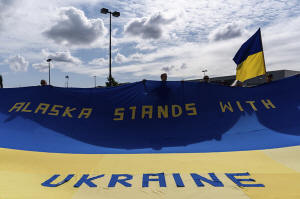Trump and Putin to meet in Alaska for high-stakes summit on
Russia-Ukraine war
[August 15, 2025]
By MICHELLE L. PRICE and WILL WEISSERT
ANCHORAGE, Alaska (AP) — U.S. President Donald Trump is meeting
face-to-face with Russian President Vladimir Putin in Alaska on Friday
for a high-stakes summit that could determine not only the trajectory of
the war in Ukraine but also the fate of European security.
The sit-down offers Trump a chance to prove to the world that he is both
a master dealmaker and a global peacemaker. He and his allies have cast
him as a heavyweight negotiator who can find a way to bring the
slaughter to a close, something he used to boast he could do quickly.
For Putin, a summit with Trump offers a long-sought opportunity to try
to negotiate a deal that would cement Russia’s gains, block Kyiv’s bid
to join the NATO military alliance and eventually pull Ukraine back into
Moscow’s orbit.
There are significant risks for Trump. By bringing Putin onto U.S. soil,
the president is giving Russia's leader the validation he desires after
his ostracization following his invasion of Ukraine 3 1/2 years ago. The
exclusion of Ukrainian President Volodymyr Zelenskyy from the summit
also deals a heavy blow to the West’s policy of “nothing about Ukraine
without Ukraine” and invites the possibility that Trump could agree to a
deal that Ukraine does not want.
Any success is far from assured, especially as Russia and Ukraine remain
far apart in their demands for peace. Putin has long resisted any
temporary ceasefire, linking it to a halt in Western arms supplies and a
freeze on Ukraine’s mobilization efforts, which were conditions rejected
by Kyiv and its Western allies.

Trump on Thursday said there was a 25% chance that the summit would
fail, but also floated the idea that if the meeting succeeds he could
bring Zelenskyy to Alaska for a subsequent, three-way meeting, a
possibility that Russia hasn't agreed to.
When asked in Anchorage about Trump's estimate of a 25% chance of
failure, Russian Foreign Minister Sergei Lavrov told reporters that
Russia “never plans ahead.”
"We know that we have arguments, a clear, understandable position. We
will state it,” he said in footage posted to the Russian Foreign
Ministry’s Telegram channel.
Trump said in a Fox News radio interview Thursday that he didn't know if
they would get “an immediate ceasefire” but he wanted a broad peace deal
done quickly. That seemingly echoes Putin’s longtime argument that
Russia favors a comprehensive deal to end the fighting, reflecting its
demands, not a temporary halt to hostilities.
The Kremlin said Trump and Putin will first sit down for a one-on-one
discussion, followed by the two delegations meeting and talks continuing
over “a working breakfast.” They are then expected to hold a joint press
conference.
Trump has offered shifting explanations for his meeting goals
In the days leading up to the summit, set for a military base near
Anchorage, Trump described it as “ really a feel-out meeting.” But he's
also warned of “very severe consequences” for Russia if Putin doesn't
agree to end the war and said that though Putin might bully other
leaders, “He’s not going to mess around with me.”
Trump’s repeated suggestions that a deal would likely involve “some
swapping of territories” — which disappointed Ukraine and European
allies — along with his controversial history with Putin have some
skeptical about what kind of agreement can be reached.

Ian Kelly, a retired career foreign service officer who served as the
U.S. ambassador to Georgia during the Obama and first Trump
administrations, said he sees “no upside for the U.S., only an upside
for Putin.”
“The best that can happen is nothing, and the worst that can happen is
that Putin entices Trump into putting more pressure on Zelenskyy,” Kelly
said.
George Beebe, the former director of the CIA’s Russia analysis team who
is now affiliated with the Quincy Institute for Responsible Statecraft,
said there’s a serious risk of blown expectations or misunderstandings
for a high-level summit pulled together so quickly.
“That said, I doubt President Trump would be going into a meeting like
this unless there had been enough work done behind the scenes for him to
feel that there is a decent chance that something concrete will come out
of it,” Beebe said.
[to top of second column]
|

People hold a large Ukrainian flag during a rally in Anchorage,
Alaska, Thursday, Aug. 14, 2025, ahead of a meeting between
President Donald Trump and Russia's President Vladimir Putin. (AP
Photo/Jae C. Hong)

Zelenskyy has time and again cast doubts on Putin's willingness to
negotiate in good faith. His European allies, who’ve held
increasingly urgent meetings with U.S. leaders over the past week,
have stressed the need for Ukraine to be involved in any peace
talks.
Political commentators in Moscow, meanwhile, have relished that the
summit leaves Ukraine and its European allies on the sidelines.
Dmitry Suslov, a pro-Kremlin voice, expressed hope that the summit
will “deepen a trans-Atlantic rift and weaken Europe’s position as
the toughest enemy of Russia.”
The summit could have far-reaching implications
On his way to Anchorage Thursday, Putin arrived in Magadan in
Russia’s Far East, according to Russian state news agency Interfax.
Kremlin spokesman Dmitry Peskov said the visit would include
meetings with the regional governor and stops at several key sites,
including a stop to lay flowers at a WWII-era memorial honoring
Soviet-American aviation cooperation.
Foreign governments will be watching closely to see how Trump reacts
to Putin, likely gauging what the interaction might mean for their
own dealings with the U.S. president, who has eschewed traditional
diplomacy for his own transactional approach to relationships.
The meeting comes as the war has caused heavy losses on both sides
and drained resources.
Ukraine has held on far longer than some initially expected since
the February 2022 invasion, but it is straining to hold off Russia’s
much larger army, grappling with bombardments of its cities and
fighting for every inch on the over 600-mile (1,000-kilometer) front
line.
Andrea Kendall-Taylor, a senior fellow and director of the
Transatlantic Security Program at the Center for a New American
Security, said U.S. antagonists like China, Iran and North Korea
will be paying attention to Trump's posture to see “whether or not
the threats that he continues to make against Putin are indeed
credible.”

“Or, if has been the past track record, he continues to back down
and look for ways to wiggle out of the kind of threats and pressure
he has promised to apply,” said Kendall-Taylor, who is also a former
senior intelligence officer.
While some have objected to the location of the summit, Trump has
said he thought it was “very respectful” of Putin to come to the
U.S. instead of a meeting in Russia.
Sergei Markov, a pro-Kremlin Moscow-based analyst, observed that the
choice of Alaska as the summit’s venue “underlined the distancing
from Europe and Ukraine.”
Being on a military base allows the leaders to avoid protests and
meet more securely, but the location carries its own significance
because of its history and location.
Alaska, which the U.S. purchased from Russia in 1867, is separated
from Russia at its closest point by just 3 miles (less than 5
kilometers) and the international date line.
Joint Base Elmendorf-Richardson was crucial to countering the Soviet
Union during the Cold War. It continues to play a role today, as
planes from the base still intercept Russian aircraft that regularly
fly into U.S. airspace.
___
Weissert reported from Washington. Associated Press writers Matthew
Lee in Washington, Elise Morton in London and Vladimir Isachenkov in
Moscow contributed to this report.
All contents © copyright 2025 Associated Press. All rights reserved
 |